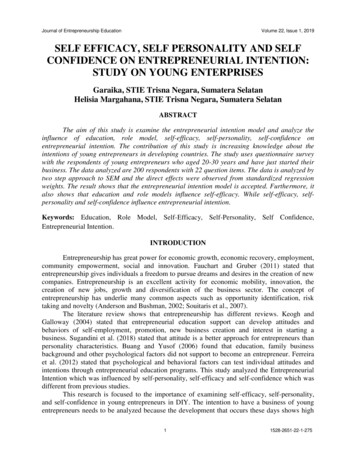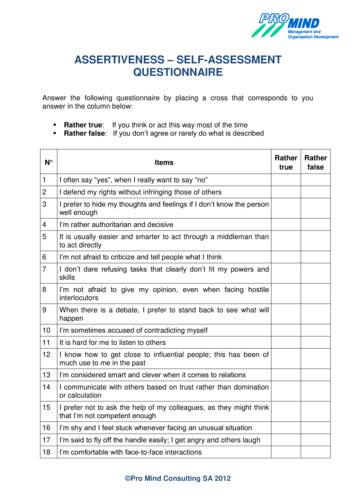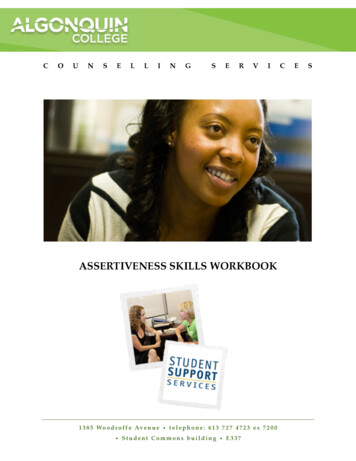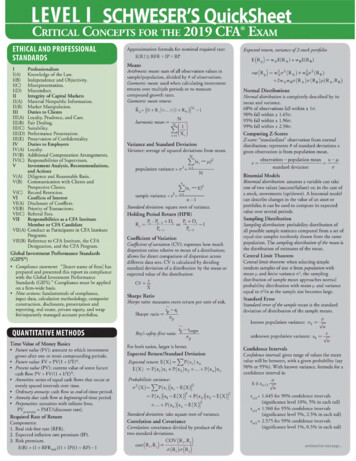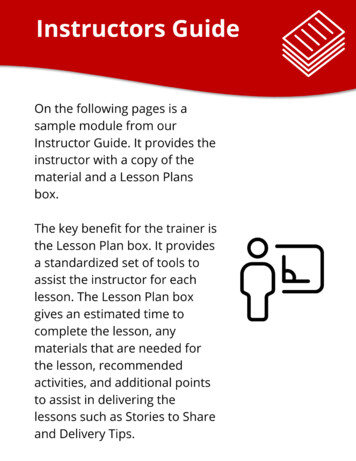
Transcription
Corporate Training Materialwww.corporatetrainingmaterials.com
Who has confidence in himself will gain theconfidence of othersLeib LazarowSample Module: What Does Self-Confidence Mean To You?Self-confidence plays an important role in our everyday lives. Beingconfident allows us to set and reach our goals. It provides stability whenwe are faced with a challenge; it gives us that push that helps usovercome difficulties. Self-confidence is necessary in our personal andprofessional lives, as without it one would not be successful in either. Itgives us the ability to stand up to face our challenges and to pickourselves up when we fall.What is Assertiveness?An assertive person is confident and direct in dealing with others. Assertivecommunications promote fairness and equality in human interactions, based on apositive sense of respect for self and others. It is the direct communication of aperson’s needs, wants, and opinions without punishing, threatening, or puttingdown another person.Assertive behavior includes the ability to stand up for a person’s legitimate rights – without violating therights of others or being overly fearful in the process. A skill that can be learned, assertive behavior issituational specific; meaning different types of assertive behavior can be used in different situations.Assertive behavior involves three categories of skills; self-affirmation, expressing positive feelings, andexpressing negative feelings. Each will be explored during this course.Estimated Time15 minutesTopic ObjectiveTo appreciate the value in oneself and others as a first step toward practicingassertiveness Corporate Training Materialwww.corporatetrainingmaterials.com
Know YourselfTopic SummaryThe ability to be assertive, rather than aggressive or passive, comes fromunderstanding that as a person, you have value. This exercise helpsparticipants understand how they see themselves and others.Materials RequiredPaper and pensPlanning ChecklistNoneProvide paper to each participant. Ask everyone to: Draw a self-portrait. (Explain to reluctant participants that this is notan art contest.) Turn the paper over and write five words they would use toaccurately describe themselves. Encourage them to use the first fivewords that come to mindDivide participants into groups of four. Tell group members to: Show their drawings to each other Ask them to pay particular attention to things like how much spacethe drawing takes up -- or whether positive or negative words wereused in the description. Once they have looked at other people's drawings, ask everyone toanalyze their own work and share any insights with the group. Have group members post their pictures on the wall. Ask everyone spend a moment writing something positive on eachpicture. Conclude the exercise by allowing members time to read the positivestatements other people have written about them.Recommended ActivityIn debrief, ask:How do you feel when you see positive words, as opposed to negativewords? Corporate Training Materialwww.corporatetrainingmaterials.com
What is Self-Confidence?Self-confidence is a belief in oneself, one's abilities, or one's judgment. It isfreedom from doubt. When you believe you can change things -- or make adifference in a situation, you are much more likely to succeed.As a self-confident person, you walk with a bounce in your step. You can controlyour thoughts and emotions and influence others. You are more prepared to tackleeveryday challenges and recover from setbacks. This all leads to a greater degree ofoptimism and life satisfaction.Estimated Time10 minutesTopic ObjectiveTo identify self-confidence actions and behaviors in a classic poem aboutassertiveness“If”Topic SummaryThe Rudyard Kipling poem “if” offers a number of tenets for assertivebehavior. In this exercise, we ask participants to list 3-5 behaviors describedin the poem that foster self-confidence.Handout One: “if” by Rudyard KiplingMaterials RequiredFlip chart paper and markersPlanning ChecklistNoneDivide participants into groups of four. Provide the handout to eachparticipant.Tell the groups to read the Kipling poem.Recommended ActivityAsk each group to list on flip chart paper 3-5 behaviors (in modern daylanguage) that we can take from the Kipling poem as best practices to fosterself-confidence.Reconvene the large group.In debrief: Corporate Training Material Compare findings among groups. Ask: What are some of the challenges of behaving with selfconfidence in today’s world?www.corporatetrainingmaterials.com
An electrician went to a life coach:Coach: What stops you noticing all the opportunities around you?Electrician: Fear of failureCoach: What would you like instead?Electrician: ConfidenceCoach: What stops you feeling confident?Electrician: Fear of failureCoach: What would you like instead?Electrician: ConfidenceCoach: Notice the loop? Now can I ask you - do you really want to change?Stories to ShareElectrician: Yes I want to. I want the confidence to make the changesCoach: OK. SO imagine 3 light bulbs screwed into a board with a commoncable. The first one is a 10 watt, second 100 watt, and third 1000 watt bulb.What bulb is the brightest?Electrician: The third oneCoach: If the same cable brings equal power to each socket, what's thedifference?Electrician: Electrical resistance - ah, I see it is me that is resistingopportunity.Coach: Life, like electricity consists of pure energy. It flows through all is usequally. There is no end to this supply - only you can cut it off throughresistance. Stop blaming external factors and accept full responsibility foryour 007/02/lesson-on-selfconfidence.htmlReview Questions Corporate Training MaterialLet’s list three behaviors of self-confidence.www.corporatetrainingmaterials.com
The Four StylesThere are four styles of communication: passive, aggressive, passive-aggressive, andassertive.The Passive PersonPassive behavior is the avoidance of the expression of opinions or feelings, protectingone’s rights, and identifying and meeting one’s needs. Passive individuals exhibit poor eye contact andslumped body posture, and tend to speak softly or apologetically. Passive people express statementsimplying that: “I’m unable to stand up for my rights.” “I don’t know what my rights are.” “I get stepped on by everyone." “I’m weak and unable to take care of myself.” “People never consider my feelings.”The Aggressive PersonAn aggressive individual communicates in a way that violates the rights of others. Thus, aggressivecommunicators are verbally or physically abusive, or both. Aggressive communication is born of low selfesteem, often caused by past physical or emotional abuse, unhealed emotional wounds, and feelings ofpowerlessness.Aggressive individuals display a low tolerance for frustration, use humiliation, interrupt frequently, anduse criticism or blame to attack others. They use piercing eye contact, and are not good listeners.Aggressive people express statements implying that: The other person is inferior, wrong, and not worth anything The problem is the other person’s fault They are superior and right They will get their way regardless of the consequences They are entitled, and that the other person “owes” them.The Passive-Aggressive PersonThe passive-aggressive person uses a communication style in which the individual appears passive onthe surface, but is really acting out anger in a subtle, indirect, or behind-the-scenes way. Corporate Training Materialwww.corporatetrainingmaterials.com
Passive-aggressive people usually feel powerless, stuck, and resentful. Alienated from others, they feelincapable of dealing directly with the object of their resentments. Rather, they express their anger bysubtly undermining the real or imagined object of their resentments. Frequently they mutter tothemselves instead of confronting another person. They often smile at you, even though they are angry,use subtle sabotage, or speak with sarcasm.Passive-aggressive individuals use communication that implies: “I’m weak and resentful, so I sabotage, frustrate, and disrupt.” “I’m powerless to deal with you head on so I must use guerilla warfare.” “I will appear cooperative, but I’m not.”The Assertive PersonAn assertive individual communicates in a way that clearly states his or her opinions and feelings, andfirmly advocates for his or her rights and needs without violating the rights of others. Assertivecommunication is born of high self-esteem. Assertive people value themselves, their time, and theiremotional, spiritual, and physical needs. They are strong advocates for themselves -- while being veryrespectful of the rights of others.Assertive people feel connected to other people. They make statements of needs and feelings clearly,appropriately, and respectfully. Feeling in control of themselves, they speak in calm and clear tones, aregood listeners, and maintain good eye contact. They create a respectful environment for others, and donot allow others to abuse or manipulate them.The assertive person uses statements that imply: “I am confident about who I am.” “I cannot control others, but I control myself.” “I speak clearly, honestly, and to the point.” “I know I have choices in my life, and I consider my options. I am fully responsible for my ownhappiness.” “We are equally entitled to express ourselves respectfully to one another.”Estimated Time15 minutesTopic ObjectiveTo practice identifying statements as aggressive, passive, passive-aggressive,or assertive Corporate Training Materialwww.corporatetrainingmaterials.com
What Type Communication?Topic SummaryIt takes practice to learn to discriminate the differences between the fourcommunication types. This exercise gives individuals that opportunity issafe, small group environmentMaterials RequiredWorksheet One: What Type Communication?Planning ChecklistNoneDivide participants into groups of four and distribute the worksheet.Recommended ActivityAsk groups to review the situations in statements and then classify eachaggressive, passive, passive-aggressive, or assertive.(Answers to the exercises are provided below.)In debrief, discuss the responses to the exercises with the large group:Review Questions How difficult was it to evaluate the communication type for eachstatement? How can an understanding of the four communication types helpyou at work, or elsewhere?Remind participants to consider adding an item to their action plan.Case StudyIt seems that today, many people who are used to saying yes are taken for granted, and used by otherpeople. Steven had to live with the idea for 20 years which he spent working at a job he did not enjoyand for people who he did not like at all. He never said no to anyone, until an event changed the way hethought.At work, a new person was hired who was extremely confident and knew how to say no without feelingashamed. This idea quickly brought him up the ladder and he became a chief in no time. Steven took theidea and started to improve his self-confidence which granted him a good belief in his abilities andjudgment. In the end, Steven managed to know when to accept to do something and when to say no,which improved his life a lot. Corporate Training Materialwww.corporatetrainingmaterials.com
Module Two: Review Questions1) Which of the following is not a skill involved by assertive behavior?a)b)c)d)Self-affirmationAggressive imposing opinion on othersExpressing positive feelingsExpressing negative feelings2) Which of the following statements IS NOT true?a)b)c)d)Assertive communications promote fairness and equality in human interactionsAssertive behavior includes the ability to stand up for a person’s legitimate rightsAssertive behavior can be learnedAssertive behavior is universal and the same for every situation3) Self-confidence is freedom from:a)b)c)d)FearsOther peopleDoubtAnxiety4) Who wrote the poem “If”?a)b)c)d)Rudyard KiplingWalt WhitmanTS EliotEmily Dickinson5) Which of the following is not a type of ssive – assertive6) Which of the following statements IS NOT true?a) An assertive individual communicates in a way that clearly states his or her opinions andfeelingsb) Assertive people feel connected to other peoplec) Assertive people are manipulatorsd) Assertive people maintain good eye contact Corporate Training Materialwww.corporatetrainingmaterials.com
Corporate Training Materialwww.corporatetrainingmaterials.com
Corporate Training Materialwww.corporatetrainingmaterials.com
Corporate Training Materialwww.corporatetrainingmaterials.com
Corporate Training Materialwww.corporatetrainingmaterials.com
Corporate Training Materialwww.corporatetrainingmaterials.com
Corporate Training Materialwww.corporatetrainingmaterials.com
Corporate Training Materialwww.corporatetrainingmaterials.com
Corporate Training Materialwww.corporatetrainingmaterials.com
Corporate Training Materialwww.corporatetrainingmaterials.com
Sample Worksheet One: What Type of Communication?Read each situation and response below. Decide what type of communication or behavior is beingmade: ion: Your co-worker Bill has just arrived an hour late for a business dinner while traveling . Hedid not call to let you know he would be detained. You're annoyed about his lateness.What You Say or DoThat's OK. Shall we eat now?Type of CommunicationI've been waiting an hour. I would have appreciated a phone call to letme know that you would be late.You've got a lot of nerve coming late.That's OK. (Then you conveniently make an excuse to go back to yourroom and work before dessert.)Situation: Your co-worker Sue continually gives you her work to do. You've decided to put an end tothis. Now, she just asked you to do more of her work.What You Say or DoI'm kind of busy. But if you can't get it done, I guess I can help you.Type of Communication“OK”, you say, and then you tell the boss.Forget it. It's about time you do your homework. You treat me likeyour slave. You're so inconsiderate.No, Sue, I'm not doing any more of your work. I'm tired of doing bothyour work and my work. Corporate Training Materialwww.corporatetrainingmaterials.com
Situation: Janelle, a manager, has just complimented you on your new suit. It's the first time you'veworn it, and you really like it.What You Say or DoType of CommunicationThank you.Thanks. Aren't you getting a new suit too?Well, I picked it up on sale.I'm so fortunate to be able to pick up designer clothes for my job.Situation: Your supervisor just gave you a mediocre annual performance review.What You Say or DoI understand. Maybe the workload should be lighter.Type of CommunicationI appreciate your feedback and would like to know how I can do betterin the coming monthsI don't think you like me very much. Maybe I should quit.You hang your head.AnswersSituation: Your co-worker has just arrived an hour late for a business dinner while traveling . He didnot call to let you know he would be detained. You're annoyed about his lateness.That's OK. Shall we eat now? (Passive)I've been waiting an hour. I would have appreciated a phone call to let me know that you wouldbe late. (Assertive)You've got a lot of nerve coming late. (Aggressive)That's OK. (Then you conveniently make an excuse to go back to your room and work beforedessert.) (Passive-aggressive)Situation: Your co-worker Sue continually gives you her work to do. You've decided to put an end tothis. Now, she just asked you to do more of her work.I'm kind of busy. But if you can't get it done, I guess I can help you. (Passive)“OK”, you say, and then you tell the boss. (Passive-aggressive) Corporate Training Materialwww.corporatetrainingmaterials.com
Forget it. It's about time you do your homework. You treat me like your slave. You're soinconsiderate. (Aggressive)No, Sue, I'm not doing any more of your work. I'm tired of doing both your work and my work.(Assertive)Situation: A manager has just complimented you on your new suit. It's the first time you've worn it,and you really like it.Thank you. (Assertive)Thanks. Aren't you getting a new suit too? (Aggressive)Well, I picked it up on sale. (Passive)I'm so fortunate to be able to pick up designer clothes for my job. (Passive-aggressive)Situation: Your supervisor just gave you a mediocre annual performance review.I understand. Maybe the workload should be lighter. (Passive-aggressive)I appreciate your feedback and would like to know how I can do better in the coming months.(Aggressive)I don't think you like me very much. Maybe I should quit. (Aggressive)In response, you hang your head. (Passive) Corporate Training Materialwww.corporatetrainingmaterials.com
Sample Worksheet 2 Rudyard Kipling'if' by Rudyard Kipling (1865-1936)If you can keep your head when all about youAre losing theirs and blaming it on you;If you can trust yourself when all men doubt you,But make allowance for their doubting too;If you can wait and not be tired by waiting,Or, being lied about, don't deal in lies,Or, being hated, don't give way to hating,And yet don't look too good, nor talk too wise;If you can dream - and not make dreams your master;If you can think - and not make thoughts your aim;If you can meet with triumph and disasterAnd treat those two imposters just the same;If you can bear to hear the truth you've spokenTwisted by knaves to make a trap for fools,Or watch the things you gave your life to broken,And stoop and build 'em up with worn-out tools;If you can make one heap of all your winningsAnd risk it on one turn of pitch-and-toss,And lose, and start again at your beginningsAnd never breath a word about your loss;If you can force your heart and nerve and sinewTo serve your turn long after they are gone,And so hold on when there is nothing in youExcept the Will which says to them: "Hold on";If you can talk with crowds and keep your virtue,Or walk with kings - nor lose the common touch;If neither foes nor loving friends can hurt you;If all men count with you, but none too much;If you can fill the unforgiving minuteWith sixty seconds' worth of distance run Yours is the Earth and everything that's in it,And - which is more - you'll be a Man my son! Corporate Training Materialwww.corporatetrainingmaterials.com
Icebreaker One: The 10 Minute ChallengePURPOSEIt will help introduce the topic of time management in a fun, non-confrontational manner.MATERIALS REQUIRED1. Flip chart paper2. Markers3. Timer or watch4. Craft supplies if desired (colored paper and pencils, glue, sparkles, etc.)PREPARATIONWrite out the following list on a piece of flip chart paper. Ensure that it stays covered until the end ofthe activity explanation.5. Do a lap around the room (5 points)6. Create something for the instructor to wear, such as a hat or tie (10 points; bonus 5 points if theinstructor actually wears it)7. Find out something unique about each person on the team (5 points)8. Sing a song together (15 points)9. Make a paper airplane and throw it from one end of the room to another (10 points)10. Get everyone in the room to sign a single piece of paper (5 points)11. Count the number of pets owned by your group (20 points)12. Assign a nickname to each member of the team (5 points)13. Create name cards for each team member (5 points; bonus 5 points if you use your teamnicknames)14. Make a tower out of the materials owned by your group (10 points)15. Convince a member of another team to join you (20 points)16. Name your team and come up with a slogan (5 points for the name, 5 points for the slogan)17. Re-create the sounds of the Amazon rainforest with the sounds of your voices (10 points)18. Make a list of what your team wants out of the workshop (15 points)19. Form a conga line and conga from one end of the room to another (5 points; bonus 10 points ifanyone joins you)You can customize this list as you wish; just make sure there is a point value (which is completely up toyou) assigned to each item. Corporate Training Materialwww.corporatetrainingmaterials.com
You will also want to create a scoreboard matrix on flip chart paper that looks like this:TEAM 1TEAM 2TEAM 3TASK 1TASK 2TASK 3TASK 4 (AND ON )TOTALThis should stay hidden until the end of the activity.EXPLANATIONDivide participants into teams of five to eight. Unveil the numbered list of tasks. Explain that they haveten minutes to collect as many points as possible. They must be safe and they only have ten minutes!ACTIVITYGive participants ten minutes to perform their tasks, and enjoy the show! After ten minutes, add uptheir points using your pre-designed matrix and announce the winner. Keep the list of tasks; you maywant to tape it to the wall.DEBRIEFAfter the activity, discuss learning points. Possible discussion topics include:20. How did teams decide what tasks they wanted to do? Most groups will analyze the time the taskwill take and/or the difficulty level, compare it with the value (possible number of points), andprioritize as a result. We do this when managing our time, too: we often choose the high-yield,low-effort tasks over the low-yield, high-effort tasks (and rightly so!).21. Were any decisions based on task dependencies? For the name card task, for example, teamsreceived bonus points if they used team nicknames. Performing these two tasks together wouldtriple the points received. This often happens in life, too – batching tasks increases your resultsexponentially.22. What group dynamics came into play? If participants knew each other before, they may feelmore comfortable performing a personally risky activity, like singing a song. This comes into play Corporate Training Materialwww.corporatetrainingmaterials.com
when prioritizing tasks, too; we’re more likely to stay within our comfort zone, especially ifwe’re working in a team.23. What skills came into play? For example, several tasks involved creativity and artistic skills. Didteams find out whether any members had artistic talent before deciding to do the task?24. What additional information did you ask for? How did that affect your approach? Some groupswill catch on to the fact that there is no rule that the whole group must perform every task, andwill divide their resources and achieve more points as a result. The lesson to learn here is thatyou need all the information you can get before prioritizing tasks and making a plan. Someteams may have even realized this partway through the activity and adjusted their approach asa result. Kudos to them!25. Did ethics come into play? Although “stealing” another team member was worth a lot of points,some teams are uncomfortable with the idea and avoid this task. Corporate Training Materialwww.corporatetrainingmaterials.com
Corporate Training Materialwww.corporatetrainingmaterials.com
CERTIFICATE OF COMPLETION[Name]Has mastered the courseAssertiveness and Self ConfidenceAwarded this day of , 20Presenter Name and Titlewww.corporatetrainingmaterials.com Corporate Training Material
Assertiveness and Self-Confidence Sample . Corporate Training Materials . All of our training products are fully customizable and are perfect forone day and half day workshops. You can easily update or insert your own co


